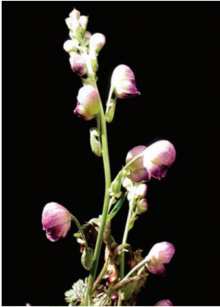tr
kırıntılardaki isimler


அதிவிடயம் (Aconitum heterophyllum) மலைப்பகுதிகளில் வளரும் ஒரு குறுஞ்செடியாகும். அகன்ற இலைகளுடன் நீலநிற பூக்களுடைய இச்செடி மருத்துவகுணம் கொண்டது.[1] ஆயுர்வேதம், ஹோமியோபதி போன்ற மருத்துவ முறைகளில் பயன்படுத்தப்படுகிறது.[2]
சுரம், அதிசாரம், சளி, அஜீரணம் போன்ற நோய்களைக் குணமாக்க சித்த மருத்துவர்கள் அதிவிடயத்தைப் பயன்படுத்துகிறார்கள். நேபாள பரம்பரை மருத்துவர்கள் அதிவிடய பொடியுடன் தேன் சேர்த்து இருமல், வயிற்றுப்போக்கு ஆகிய நோய்களுக்கு தருகிறார்கள். அதிவிவிடயத்தை காய்ச்சி வயிற்று வலிக்கு கொடுக்கிறார்கள். ஜம்மு–காஷ்மீரத்து மலைவாழ் மக்கள் பசியின்மைக்கு பயன்படுத்துகிறார்கள். ஆயுர்வேத முறையில் அதிவிடயம் அதிகம் பயன்படுத்தப்படுகிறது. ஓமியோபதி மற்றும் யுனானி மருத்துவத்திலும் அதிவிடயம் உபயோகிக்கப்படுத்தப்படுகிறது.
அதிவிடயம் (Aconitum heterophyllum) மலைப்பகுதிகளில் வளரும் ஒரு குறுஞ்செடியாகும். அகன்ற இலைகளுடன் நீலநிற பூக்களுடைய இச்செடி மருத்துவகுணம் கொண்டது. ஆயுர்வேதம், ஹோமியோபதி போன்ற மருத்துவ முறைகளில் பயன்படுத்தப்படுகிறது.
சுரம், அதிசாரம், சளி, அஜீரணம் போன்ற நோய்களைக் குணமாக்க சித்த மருத்துவர்கள் அதிவிடயத்தைப் பயன்படுத்துகிறார்கள். நேபாள பரம்பரை மருத்துவர்கள் அதிவிடய பொடியுடன் தேன் சேர்த்து இருமல், வயிற்றுப்போக்கு ஆகிய நோய்களுக்கு தருகிறார்கள். அதிவிவிடயத்தை காய்ச்சி வயிற்று வலிக்கு கொடுக்கிறார்கள். ஜம்மு–காஷ்மீரத்து மலைவாழ் மக்கள் பசியின்மைக்கு பயன்படுத்துகிறார்கள். ஆயுர்வேத முறையில் அதிவிடயம் அதிகம் பயன்படுத்தப்படுகிறது. ஓமியோபதி மற்றும் யுனானி மருத்துவத்திலும் அதிவிடயம் உபயோகிக்கப்படுத்தப்படுகிறது.
Aconitum heterophyllum, also called atish/atis/patis/ativish/atvika, is a species of flowering plant in the genus Aconitum. It is used in Indian systems of traditional medicine including Ayurveda.[3]
Available in the slopes in sub alpine and alpine areas between 2500- 3500m. Jammu & Kashmir, Himachal Pradesh and Uttarakhand. Pakistan and Nepal.
Medicinal Use : Roots are used to cure dysentery, diarrhea, fever, malarial fever, cough, cold colic, headache, piles, hysteria, throat infection, cure for dyspepsia, especially when appetite is lost after illness and also in vomiting, abdominal pain and diabetes. It also checks excessive menstrual flow. Fresh leaves used to cure toothache.
 Aconitum heterophyllum
Aconitum heterophyllum Aconitum heterophyllum, also called atish/atis/patis/ativish/atvika, is a species of flowering plant in the genus Aconitum. It is used in Indian systems of traditional medicine including Ayurveda.
Available in the slopes in sub alpine and alpine areas between 2500- 3500m. Jammu & Kashmir, Himachal Pradesh and Uttarakhand. Pakistan and Nepal.
Medicinal Use : Roots are used to cure dysentery, diarrhea, fever, malarial fever, cough, cold colic, headache, piles, hysteria, throat infection, cure for dyspepsia, especially when appetite is lost after illness and also in vomiting, abdominal pain and diabetes. It also checks excessive menstrual flow. Fresh leaves used to cure toothache.
Aconitum heterophyllum (Wall. ex Royle, 1834) è una pianta erbacea appartenente alla famiglia delle Ranunculaceae, originaria di zone d'alta montagna dell’Himalaya[2]. Come tutte le specie del genere Aconitum possiede degli alcaloidi molto tossici, utilizzati per preparati farmacologici nella medicina ayurvedica.[1]
Pianta erbacea perenne la cui altezza può arrivare fino a 120 cm (alle altitudini più elevate fino a 30 cm). Il fusto, a portamento eretto, ha una parte inferiore ipogea con rizomi lunghi 2,5–4 cm.
Le foglie sono di forma ovata-cordata e misurano 4–8 cm; le superiori sono a margine dentato, sessili, prive di picciolo, con guaina ad avvolgere lo stelo, mentre le inferiori sono di forma lobulata, con picciolo lungo. infiorescenze costituite da racemi a spiga. I morbidi fiori, di 2,5–3 cm di diametro, sono verdastri con screziature blu o viola, parzialmente avvolti da brattee ovate. La fioritura avviene tra luglio e settembre.
I frutti sono costituiti da follicoli oblunghi di 1,6-1,8 cm, leggermente pelosi, che a maturazione rilasciano i semi tra settembre e ottobre.[3]
È specie endemica della regione montuosa dell'Himalaya tra India, Pakistan e Nepal. Predilige i pendii erbosi aperti tra i 2.400 e i 4.000 m di altitudine, al di sopra della foresta a conifere, spesso in comunità biologiche con Carex nubigena e Kobresia duthiei.[1][3]
Sono riconosciute ufficialmente 2 sottospecie e 1 varietà, con differenze morfologiche e dimensionali minime:[4][5]
Composti chimici principali presenti nella pianta: atisina, heteratisina, hetisina. Queste sostanze alcaloidi sono dannose per l'uomo. Pertanto deve essere usata sotto la vigilanza costante del medico o del farmacista.
Nella medicina ayurvedica indiana le radici disidratate vengono utilizzate per preparati fitoterapici, commercializzati con il nome di atis.[5]
Aconitum heterophyllum è minacciata a causa della raccolta intensiva per il commercio e la vendita delle parti della pianta utilizzate nella medicina tradizionale indiana; questa pratica è molto dannosa in quanto viene estirpata anche la parte ipogea, limitando le capacità riproduttive della specie. Nel 2003 venne stimato un declino dell'70 % della popolazione in 10 anni e le stime attuali (2015) hanno confermato il trend. Pertanto è inserita nella categoria EN (in pericolo di estinzione) della Lista rossa IUCN.[1]
titolo vuoto o mancante (aiuto) Aconitum heterophyllum (Wall. ex Royle, 1834) è una pianta erbacea appartenente alla famiglia delle Ranunculaceae, originaria di zone d'alta montagna dell’Himalaya. Come tutte le specie del genere Aconitum possiede degli alcaloidi molto tossici, utilizzati per preparati farmacologici nella medicina ayurvedica.
Aconitum heterophyllum là một loài thực vật có hoa trong họ Mao lương. Loài này được Wall. ex Royle mô tả khoa học đầu tiên năm 1834.[1]
Aconitum heterophyllum là một loài thực vật có hoa trong họ Mao lương. Loài này được Wall. ex Royle mô tả khoa học đầu tiên năm 1834.